
Protective Shoeing,
What it is, and how it can protect your horse from lameness
by Graeme Burt, D.W.C.F, farrier.
The training of farriers in this country focuses a great deal on the structures of the limb, bones, ligaments, tendons, blood supply, nerves, plus balance, angles, diseases and so on. I would argue that although all these things are very important to the health, wellbeing and soundness of the horse, one particular structure has been very much overlooked, and that is the health of the horn - the material surrounding the foot itself.
A lot of people think of the horn as an impregnable and indestructible material, but the truth is very far from this, it is actually designed to be destroyed as I shall demonstrate later, treating the horn with indifference on the part of horseowners, farriers and even veterinary surgeons has up to quite recently been reasonably commonplace, resulting in unnecessary lamenesses being a consequence of an artificial environment in which horses are kept.
However, with very little effort and careful management, such things can be avoided.
Many farriers are of the opinion that we work with just one material and structure, that is steel horseshoes, and they directly affect the bone structures above. I am of the opinion that we work with two - the steel and the horn, and that it should be a combination of the two that supports and protects the horse.
Both have to be in good condition in order to work correctly together. The horn is the structure through which all of the horse's support and power is transmitted from the muscles and the supporting bones to the shoes and then to the ground; all the structures above it cannot function properly if the horn cannot perform its two primary functions.
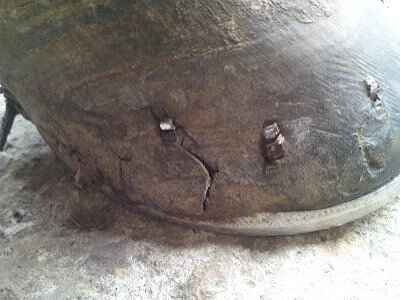 This foot is unstable. Balance here is lost, because this side has collapsed.. The wall has collapsed over the shoe, splitting over the heel nail. This horse was lame because the shoe and foot no longer supported him properly here. |
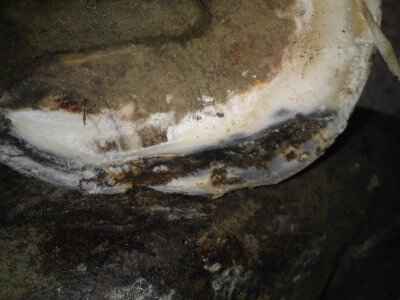 This foot is unhealthy. That black hole is actually supposed to be the white line! It is badly infected, hence the black colour. These infections cause abscesses and discomfort. A bit like having a black tooth in your foot! |
The two main functions of the horn are
1) supporting the weight of the animal.
2) protecting the inside structures from infection.
If either of these functions are impaired, it does not matter what kind of shoe is used, or how it is applied - the shoe cannot do the job for which it was intended, because the structure to which it is attached is either unstable or unhealthy, or both, as seen in the above pictures.
As an analogy, if for instance the ground beneath your house were to become unstable and begin to shift, your house would begin to break up and seperate, eventually collapsing.
Likewise should the timbers within the structure of your house go rotten and become full of disease, they will weaken to the point of collapse, with the same result.
The same applies to your horses feet - if the horn becomes unstable, balances which were originally applied can quickly change due to buckling and twisting, which quickly undoes all the careful balancing work your farrier has performed.
This can result in pressure on sensitive structures, (1) below, or infections getting into your horses feet, (2) below.
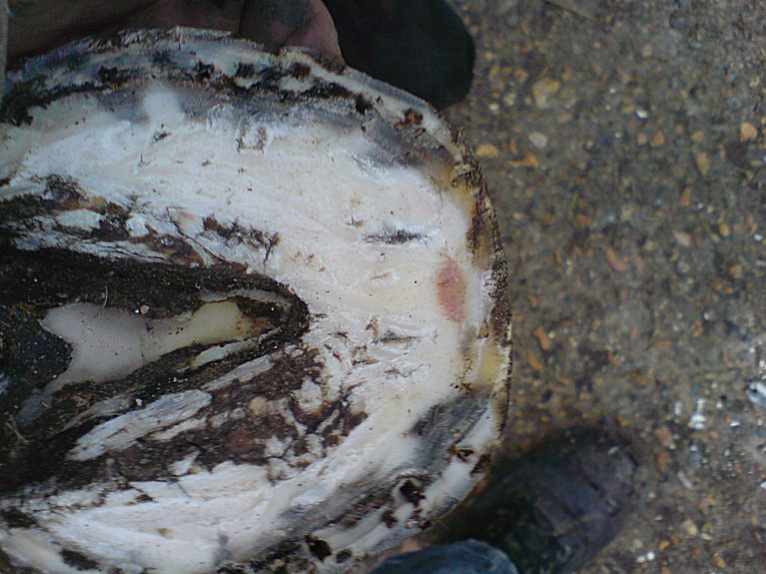 |
Pressure on sensitive
structures. (1) This thoroughbred has a bruise that can clearly be seen across the toe; it was caused by pressure from a natural balance shoe, which have a bar that crosses the toe at this point. The horn under it had been softened and thinned by wet muddy field conditions, which caused the foot to collapse onto the bar, creating pressure, which resulted in the bruising, making him lame. These feet were unprotected, and you can see the way mud has penetrated into the soft underhorn around the nails and white line area, turning it black. It started out and should be white! This is very common in unprotected feet, and, as you can see by the bruising, black infection is also close to the blood line. Painful abscesses easily form in these conditions, but more common is temporary intermittent discomfort. |
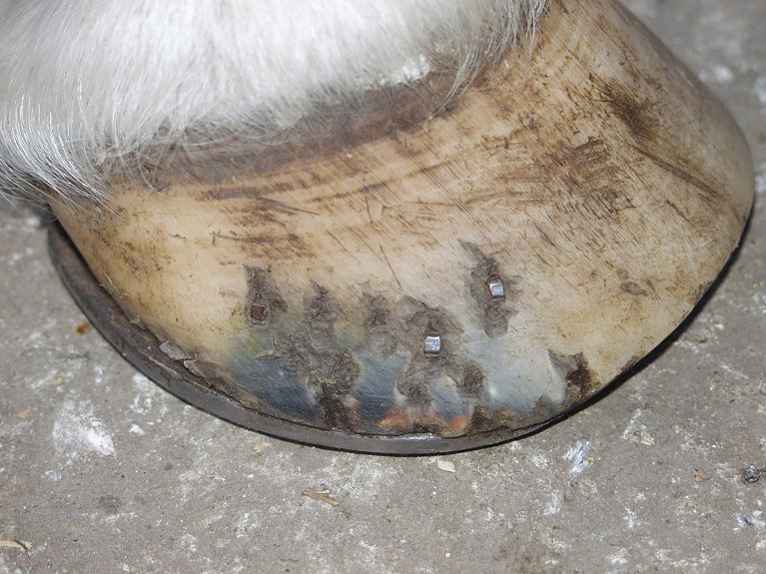 |
Infection getting in.
(2) Another unprotected foot. This foot is white - or is it? The area beneath the nails is badly infected, turning it black - this also happens with black feet, but in them it can't be seen because of their colour. The infection started from the bottom under the shoe, and went upwards, under capillary action. Dont forget this starts inside next to the white line, which means it has to be infecting the sensitive tissues in the wall by now, as it is almost half way up the foot, and inside the wall it will be worse. The sensitive tissues inside will almost certainly be weeping pus by this stage. The pus can usually escape so it is rarely detected as an abscess unless the lower area closes, which it usually cannot, because the horn is so badly infected. But it does cause real discomfort which interferes with the horse's confidence and concentration. |
Dont forget that the very first thing a farrier does before he applies shoes is to trim the feet back and balance them; this is for the valid purpose that the shoes must be apply pressures evenly to the structures above them, but like everything we do, trimming has a downside.
The downside is that having removed the excess protection from the horses foot, any horn infection does not have far to travel to get to sensitive structures. It is therefore important that horn infections are properly discouraged from accessing the areas between the shoes and the feet at the time of shoeing, although this is rarely done, and never consistently.
So why do horses feet deteriorate?
Simple answer to that question, is because the horn is designed to be a temporary, and not a permanent, structure. This sounds like a completely ridiculous statement, but if we think about it logically and in an evolutionary context, it makes perfect sense.
The necessity of feet to be destroyed was graphically illustrated to me some years ago when working in a yard which takes in RSPCA cases, at one time two horses were rescued in the same week.
One horse had very hard, tough, unbreakable feet. The feet measured a full 14 inches (34cm) at the front from top to bottom; as they grew the joints of the legs had come under such awful stress that they were hideously deformed despite the young age of the animal.
It was a piteous sight to see her try to move even when her feet had been trimmed properly, and she was destroyed because of the irreversible permanent damage to her joints.
The second horse's feet were irregular, cracked around the base and broken away, but this horse was able to walk reasonably normally. Once her feet had been trimmed properly and she recovered her weight she passed on to a home where she was capable of working; but this horse actually survived because during the long years of neglect, her feet were capable of self-destruction in time, so despite her neglect, her joints were left relatively undamaged.
In the wild therefore, natural selection would have favoured the horse who's feet broke away, even though horse owners today would consider this a bad thing. But wild horses do not simply wear their feet away walking about.
There are times of plenty when they hardly travel at all, yet their feet still get destroyed. It can be a good thing to have horn which can be naturally destroyed, indeed there are good evolutionary reasons why it happens. Dont forget, in the wild, and over hundreds of thousands of years of evolution, nobody has ever come to trim the horses feet!
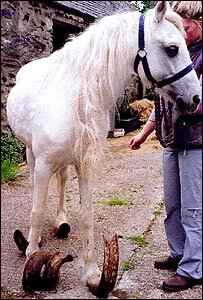 |
This
picture illustrates the constant growth of horn that is not being
naturally destroyed; these feet have grown continuously placing
constant massive strains on the joints above. It is clear that in wild
conditions this horse would not have survived due to its inability to
run (or even walk in this particularly severe case of neglect). This is not the first horse I refer to in my text, as there are no pictures to illustrate her condition. In a way this horse is not as bad, for the horse I refer to had toes that had not turned up, so the entire foot was extended fourteen inches along the ground in front of her, creating a lever on the fetlock, coronary and pedal joints that left them all hideously deformed. Picture courtesy BBC/RSPCA |
This is one of the reasons I decided to study how and why the horn surrounding the the foot is naturally destroyed, how it relates to shoeing, and how shoeing affects this process and can accelerate it, and more importantly, what we can do to stop the damage that shoes can do.
I have found that most of the horses that encounter foot lamenesses, and especially unexplained lamenesses or discomfort, invariably have a far greater rate of horn destruction than horn growth, even if they have shoes on.
In a lot of cases, shoes that are applied to the feet to protect them are actually encouraging the feet to deteriorate at a faster rate than they grow, which results in lameness.
To explain all this, firstly we need to consider a healthy normal foot, and how the horn structure is laid out, so we can analyze the weaknesses and the evolutionary reasons why those weaknesses exist.
© Graeme Burt DWCF